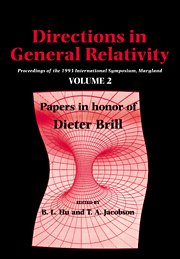 Directions in General Relativity
Directions in General Relativity Published online by Cambridge University Press: 06 January 2010
Abstract
It is shown that if a non-flat spacetime (M, g) whose future c-boundary is a single point satisfies RabVaVb ≥ 0 for all timelike vectors Va, equality holding only if Rab = 0, then sufficiently close to the future c-boundary the spacetime can be uniquely foliated by constant mean curvature compact hypersurfaces. The uniqueness proof uses a variational method developed by Brill and Flaherty to establish the uniqueness of maximal hypersurfaces.
In 1976 Dieter Brill and Frank Flaherty (1976) published an extremely important paper, “Isolated Maximal Hypersurfaces in Spacetime”, establishing that maximal hypersurfaces are unique in closed universes with attractive gravity everywhere. That is, there is only one such hypersurface, if it exists at all. In an earlier paper, Brill had established that in three-torus universes, only suitably identified flat space possessed a maximal hypersurface, so the existence of a maximal hypersurface is not guaranteed. These results by Brill are important because maximal hypersurfaces are very convenient spacelike hypersurfaces upon which to impose initial data; on such hypersurfaces the constraint equations are enormously simplified. Furthermore, in asymptotically flat space, foliations of spacetime by maximal hypersurfaces often exist, and the simplifications of the constraint equations on such a foliation make it easy to numerically solve the full four-dimensional vacuum Einstein equations for physically interesting situations.
To save this book to your Kindle, first ensure [email protected] is added to your Approved Personal Document E-mail List under your Personal Document Settings on the Manage Your Content and Devices page of your Amazon account. Then enter the ‘name’ part of your Kindle email address below. Find out more about saving to your Kindle.
Note you can select to save to either the @free.kindle.com or @kindle.com variations. ‘@free.kindle.com’ emails are free but can only be saved to your device when it is connected to wi-fi. ‘@kindle.com’ emails can be delivered even when you are not connected to wi-fi, but note that service fees apply.
Find out more about the Kindle Personal Document Service.
To save content items to your account, please confirm that you agree to abide by our usage policies. If this is the first time you use this feature, you will be asked to authorise Cambridge Core to connect with your account. Find out more about saving content to Dropbox.
To save content items to your account, please confirm that you agree to abide by our usage policies. If this is the first time you use this feature, you will be asked to authorise Cambridge Core to connect with your account. Find out more about saving content to Google Drive.